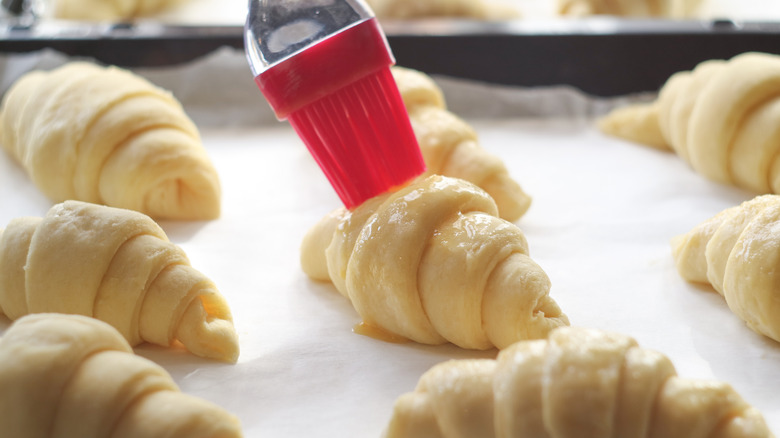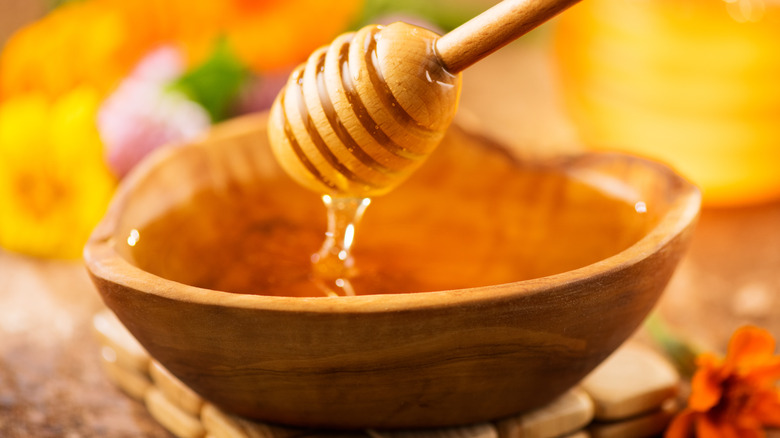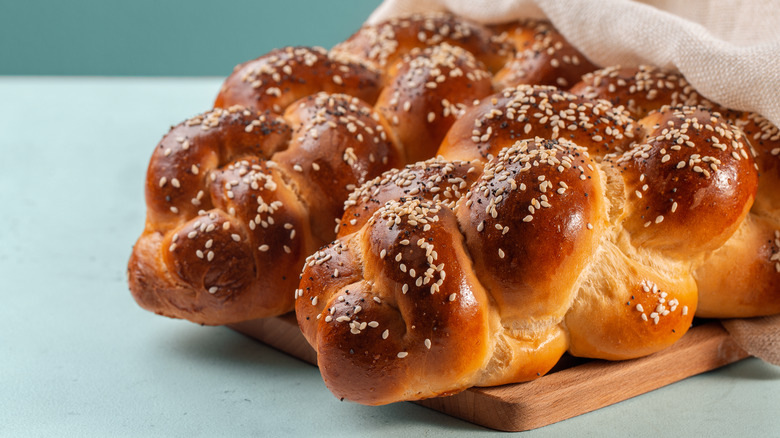What To Keep In Mind When Using Honey As An Egg Wash Replacement
Egg wash is a key baking component used to elevate the appearance and textural finish of many bakes, including hearty breads, flaky pastries, and pies. Traditional egg washes are made with either whole eggs, egg yolks, or just the whites (sometimes alongside milk), which is then applied to formed-dough prior to baking. This provides a polished sheen and crunchy exterior, but egg washes can also act as a binder to help toppings like brown-sugar crumbles adhere to the surface.
Many recipes call for egg wash. However, if you don't have eggs on hand or are avoiding them due to the cost or for dietary reasons (such as allergens or a vegan lifestyle), there are luckily several alternatives available. For instance, you can easily substitute honey for egg wash when preparing beautiful treats like cherry lattice pie.
When applied to the surface of dough — before or during the bake — a honey wash will caramelize in the heat of the oven and provide the desired golden brown exterior and glossy crust, similar in function to egg wash. When using honey, though, it's important to consider baking temperature and time. Due to its higher sugar content, honey wash can easily burn, become overly browned, and harden if kept in the oven too long or if baked with too much heat. So, apply your honey egg wash closer to the end of a bake, or use it in recipes with short baking times and those that use lower temperatures.
How to properly apply a honey coating
When using honey as a replacement for egg wash, first thin out the honey so that it can easily be brushed onto the surface of your pastry, scone, or bread dough in an even layer. The honey acts as a finishing glaze, so it shouldn't be too thick, crystallized, or gooey. If necessary, thin out your honey by microwaving it in a microwave-safe bowl for about 30 seconds, checking it at 15-second intervals, or melt your honey over low heat in a saucepan. Once it's in liquid form, mix 1 tablespoon of honey with 2 tablespoons of water, milk, or a plant-based milk alternative — such as almond milk or soy milk — and whisk to combine. For a sweeter glaze, increase the ratio of honey to liquid in your wash.
You'll want to apply your honey wash in a thin layer, using a pastry brush, just to cover the surface and sides of your bake, but the timing on this varies. For bakes with a smaller surface area that require less time in the oven, like rolls or scones, apply the honey wash directly to the surface, then add toppings like sesame seeds or coarse granulated sugar before transferring to the oven. For bakes that take a long time or call for heats higher than 350 degrees Fahrenheit, apply the honey wash during the last 10 to 15 minutes of baking to avoid burning or overly browning the sugar.
Choosing the right alternative for egg wash
There are several alternatives available if you want to get the look of egg wash without the price or simply meet dietary needs. Taking stock of your baking parameters and flavor preferences can help you choose the right option. A honey replacement for egg wash is great for providing a glossy finish on pastries or breads with a touch of sweetness, like in the case of apple butter challah. If you don't have honey on hand, though, other liquid sweeteners like maple syrup can also be used.
For more savory bakes like crusty olive bread or sourdough, you may consider other replacements for egg wash such as water, plant-based milk, or olive oil. Honey wash provides an excellent surface-sheen and glue for garnishes, but what if you're looking for an alternative that's more of a binder, one that functions like an emulsifier atop your bakes (for instance, to hold in moisture for pies with wet fillings)? Consider something with more protein, such as aquafaba (chickpea water) or flaxseed egg wash. There are many possible replacements for egg wash, but honey remains one of the best, as long as you know how to use it properly.


